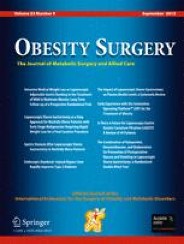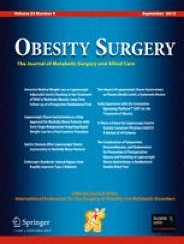- Le taux de conversion en une autre intervention 10ans apres Sleeve pour reprise de poids varie de 20 à 50% dans la littérature.
Une solution "à la carte" peut etre proposé au patient avec transformation en Re-Sleeve, Bypass en Y, Omega, SADI ou duodenal-Switch.
Une intervention secondaire peut recontroler la reprise ponderale apres une rééducation nutritionnelle > 6mois mais les risques de fistule sont légèrement majorées.

Efficacy and Drawbacks of Single-Anastomosis Duodeno-Ileal Bypass After Sleeve Gastrectomy in a Tertiary Referral Bariatric Center
A.Liagre, F.Martini, Y.Anduze, H.Boudrie, O.Van Haverbeke, N.Petrucciani
Background : The need for revisional procedures after sleeve gastrectomy (SG) for insufficient weight loss or weight regain, gastroesophageal reflux, or other complications is reported to be 18–36% in studies with 10-year follow-up. Single-anastomosis duodeno-ileal bypass (SADI) may be performed as a revisional procedure after SG. This study aims to evaluate the short- and mid-term outcomes of SADI after SG in a referral center for bariatric surgery.
Materials and Methods : Data of patients who underwent SADI between March 2015 and March 2020 were collected prospectively and analyzed retrospectively. Follow-up comprised clinical and biochemical assessment at 1, 3, 6, 12, 18, and 24 months postoperatively, and once a year thereafter.
Results : Overall, 106 patients underwent SADI after a previous SG. The timeframe between SG and SADI was 50 ± 31.3 months. Postoperative mortality was observed in two cases (1.8%) and morbidity in 15.1% of patients. At 24 months, %total weight loss was 37.6 ± 12.3 and %excess weight loss 76.9 ± 25.2 (64 patients). Three patients were treated for malnutrition during follow-up, two with medical treatment and one with SADI reversal.
Conclusion : SADI after SG provides effective weight loss results in the short-term, even if in the present series the postoperative complication rate was non-negligible. Further trials are needed to establish the more advantageous revisional bariatric procedure after failed SG.
Rendez-vous
05 62 13 31 70
Centre Digestif de la Clinique des Cèdres
Château d’Alliez
31700 CORNEBARRIEU
Accéder au Cabinet
 Laparoscopic Conversion of Sleeve Gastrectomy to One Anastomosis Gastric Bypass for Weight Loss Failure: Mid-Term Results
Laparoscopic Conversion of Sleeve Gastrectomy to One Anastomosis Gastric Bypass for Weight Loss Failure: Mid-Term Results
T.Debs, N.Petrucciani, G.Juglard, F.Martini, A.Liagre
Background : Laparoscopic sleeve gastrectomy (SG) became the most performed surgical intervention for treating population with morbid obesity. However, revisional surgery after SG has been increasingly performed due to weight loss failure. We describe the results of a single surgeon’s experience with conversion of SG to one anastomosis gastric bypass (OAGB) in patients with previous SG and weight loss failure. The aim of the study is to analyze the short- and mid-term results of conversion of SG to OAGB for failure of weight loss.
Methods : Conversion of SG to OAGB was performed in 77 patients from May 2010 to June 2018. Vertical resleeving of the gastric tube was done in all patients. A chart review was conducted to determine the weight loss mid-term results and the occurrence of postoperative complications.
Results : Revisional surgery was completed by laparoscopy in all cases. The mean operative time was 42.0 ± 8.0 min, and mean blood loss was 56.8 ± 56.7 mL. A total complication rate of 3.9% was observed. Ninety-day mortality rate was 0%. Patients mean %EWL was 80.2 (36–128) at 12-month follow-up, mean percent total weight loss (%TWL) was 0.74 (range 0.03–1.8), and mean percent excess BMI loss (%EBMIL) was 70.7%. At 24-month follow-up, mean %EWL was 84.1 (41–128), mean %TWL 0.79 (range 0.32–1.6), and mean %EBMIL 79.9%.
Conclusion : In patients with history of SG and weight loss failure, conversion from SG to OAGB is effective in terms of weight loss and has a low risk of surgical complications
- Le taux de conversion en un Bypass en Y apres Sleeve pour reflux resistant au traitement medical varie de 1 à 10% dans la littérature.
La conversion en bypass en Y chez un sujet maigre controle le reflux non contrôlable par un traitement par IPP

